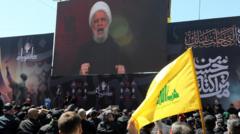What Happened in Lebanon's Bekaa Valley After Israeli Strikes Killed 12?

Understanding the Recent Escalations Between Israel and Hezbollah
Recent events in the Bekaa Valley of Lebanon have sparked renewed concerns over the fragile ceasefire between Israel and Hezbollah. With at least 12 fatalities reported from Israeli air strikes, including civilians and Syrian nationals, these incidents have raised questions about the stability of the region and the effectiveness of international mediation. As the situation unfolds, it becomes essential to understand the historical context, the implications of the current violence, and what it could mean for the future of Israeli-Lebanese relations.
The Context of the Current Conflict
The ongoing tensions between Israel and Hezbollah have deep historical roots, dating back to the Lebanese Civil War and the 2006 Lebanon War. The latest wave of violence illustrates the precarious nature of the ceasefire established after years of conflict, particularly following the extensive military engagements that took place in 2023 and early 2024.
A Brief History of the Conflict
Hezbollah, a Shiite militant group formed in the early 1980s, has been a significant force in Lebanese politics and military actions against Israel. The group emerged from the socio-political conditions of the Lebanese Civil War and has garnered support from Iran and Syria. The 2006 war led to significant casualties and destruction, resulting in United Nations Security Council Resolution 1701, which aimed to establish peace and security in the region.
The resolution called for the disarmament of all armed groups in Lebanon and mandated that Hezbollah withdraw its forces north of the Litani River. Despite this, Hezbollah has maintained military capabilities, leading to ongoing tensions and sporadic violence.
Recent Developments: The Air Strikes
On a recent day, Israeli air strikes targeted several Hezbollah military compounds in the Bekaa Valley, which resulted in the deaths of various individuals, including civilians. The Israeli Defense Forces (IDF) justified these strikes as a response to Hezbollah's military activities and an attempt to re-establish its capabilities following significant losses in the previous year.
Casualties and Impact on Civilians
The strikes led to a tragic loss of life, including a family of five from Syria and several Lebanese citizens. This raises serious humanitarian concerns, as civilians often bear the brunt of military actions in conflict zones. The escalation of violence not only affects those directly involved but also destabilizes the region, leading to a humanitarian crisis that could have long-lasting effects.
The Military Justifications
According to IDF spokesperson Lt Col Avichay Adraee, the strikes targeted Hezbollah's elite Radwan Force, which is known for its commando operations. The IDF has stated that these military compounds were being used to store weapons and prepare for future engagements against Israel. The military's rationale is that such activities constitute a direct threat to Israeli security and violate previous ceasefire agreements.
The Response from Hezbollah and the International Community
Hezbollah has yet to issue an official response to the latest air strikes, although its media outlets have condemned the actions as violations of Lebanese sovereignty. The group's silence may be a strategic decision, potentially aimed at assessing the situation before retaliating.
On the international front, the United States and other countries monitoring the situation may need to intervene diplomatically to prevent further escalation. The fragile peace established by UN Resolution 1701 is at risk, and the potential for renewed conflict poses serious threats not just to Lebanon and Israel but to the broader Middle Eastern region.
Long-term Implications of Renewed Violence
The resumption of military actions raises several critical questions regarding the future of Israeli-Lebanese relations. With both sides having entrenched positions, the possibility of reconciliation seems distant. Understanding the long-term implications of these developments is essential for regional stability.
Potential for Increased Military Engagement
The current situation suggests that Israel may ramp up its military operations against Hezbollah if it perceives a continued threat. This could lead to a cycle of violence that escalates into a broader conflict, similar to the wars seen in the past. The ongoing hostilities may push Hezbollah to retaliate, which could trigger a more significant military response from Israel.
Humanitarian Concerns and Civilian Impact
The humanitarian impact of renewed violence cannot be overstated. Civilian populations often suffer the most during conflict, facing displacement, loss of life, and disruptions to essential services. The international community must prioritize humanitarian aid and support for those affected by the violence while encouraging diplomatic solutions to prevent further military engagement.
Conclusion: The Path Forward
The recent air strikes in Lebanon highlight the fragile state of peace between Israel and Hezbollah. With a history fraught with conflict and a present filled with uncertainty, the path forward will require careful navigation by all parties involved. The international community plays a crucial role in fostering dialogue and ensuring compliance with ceasefire agreements to avoid further escalation.
As we reflect on these events, it is essential to consider the broader implications for regional stability and the humanitarian consequences of military actions. The situation remains dynamic, and vigilance is necessary to prevent a return to full-scale conflict.
FAQs
What triggered the recent Israeli air strikes in Lebanon?
The air strikes were reportedly a response to military activities by Hezbollah, particularly targeting their elite Radwan Force, which Israel views as a significant threat to its security.
How many casualties were reported from the strikes?
At least 12 people were killed, including seven Syrians and three Lebanese, according to local officials.
What is the significance of UN Resolution 1701 in this context?
UN Resolution 1701 aimed to maintain peace and security following the 2006 Lebanon War, mandating the disarmament of armed groups in Lebanon and establishing a framework for military presence in the region.
As the situation evolves, one must wonder: what steps can be taken to ensure a lasting peace in a region plagued by conflict? #Israel #Hezbollah #MiddleEastPeace
Published: 2025-07-15 15:07:09 | Category: world



